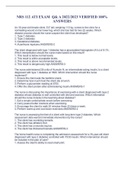Exam (elaborations)
NRS 112 ATI EXAM Q& A 2022/2023 VERIFIED 100% ANSWERS
- Course
- Institution
An 18-year-old female client, 5′4′′ tall, weighing 113 kg, comes to the clinic for a nonhealing wound on her lower leg, which she has had for two (2) weeks. Which disease process should the nurse suspect the client has developed? 1. Type 1 diabetes. 2. Type 2 diabetes. 3. Gestational diabe...
[Show more]



